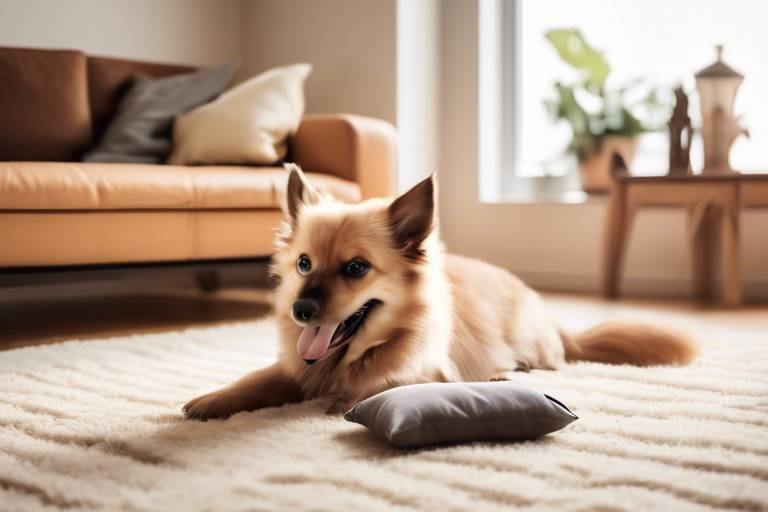How to Reduce Pet Stress During Home Renovations
Home renovations can be an exciting time for homeowners, but for our furry friends, it can often feel like a chaotic whirlwind. Imagine being a pet, lounging peacefully in your cozy spot, and suddenly, the walls are shaking, strange noises are echoing, and unfamiliar faces are wandering through your space. It's no wonder that pets can experience stress during these times! This article explores effective strategies to minimize stress for pets during home renovations, ensuring their comfort and safety while creating a peaceful environment amidst the chaos of construction.
Recognizing the signs of stress in pets is crucial during renovations. Pets can’t verbally express their discomfort, so it’s up to us to be observant. Common behaviors that indicate stress include excessive barking, hiding, loss of appetite, or even destructive behavior. If your pet suddenly becomes clingy or overly aggressive, these could be signs that they are feeling overwhelmed. Early identification of these behaviors can allow you to take appropriate action before their anxiety escalates. Just like us, pets thrive in a stable environment, and any disruption can lead to feelings of insecurity. So, keep an eye out for those subtle cues!
Preparation is key to reducing pet stress. Before the hammering and drilling begin, take some time to create a safe haven for your pet. Start by identifying areas in your home that will be off-limits during the renovations. This helps to minimize their exposure to loud noises and potential hazards. You might also consider removing any items that could potentially be dangerous to your pet, such as tools or materials that could be ingested. A little foresight goes a long way in ensuring your pet’s safety and comfort during this hectic time.
Designing a designated area for your pet can provide them with a sense of security during renovations. This safe space should be a quiet zone away from the noise and chaos, where your pet can retreat when things get overwhelming. Think of it as their personal sanctuary! A comfortable bed, their favorite toys, and perhaps a cozy blanket can transform a simple room into a calming retreat. By establishing this area, you’re giving your pet a place to feel secure and relaxed, which is essential during such a disruptive time.
Selecting an appropriate location for your pet's safe space is essential. Look for a room that’s far from the renovation activities, ideally with minimal noise and foot traffic. Consider factors such as accessibility—your pet should be able to easily enter and exit their safe zone. A basement or a room with thick carpets can help muffle sounds, making it an ideal choice. Remember, the goal is to create a peaceful environment where your pet feels at ease, so choose wisely!
Providing essential supplies in your pet's safe space can help ease their anxiety. Make sure to include:
- Bedding: A soft, comfortable bed can work wonders in helping your pet feel secure.
- Toys: Familiar toys can provide comfort and distraction from the noise.
- Food and Water: Ensure they have access to their food and water to maintain their routine.
By equipping their safe space with these essentials, you’re not just creating a physical area for your pet, but also a mental refuge that can help them cope with the stress of renovations.
Keeping a consistent routine can help alleviate stress for pets during renovations. Pets thrive on routine, and any disruption can lead to anxiety. Try to maintain feeding, walking, and playtime schedules as much as possible. If you usually take your dog for a walk at a certain time, try to stick to that schedule. This familiarity can be incredibly comforting for your pet amidst the chaos. Think of it as a beacon of normalcy in a sea of change!
Sometimes, enlisting the help of professionals can ease the burden on both pets and owners. If the renovations are extensive, consider hiring a pet sitter or utilizing boarding facilities. This can provide a much-needed break for your pet from the noise and disruption at home. It’s an option worth exploring, especially if you know your pet is particularly sensitive to stress.
Finding a reliable pet sitter can provide peace of mind during renovations. Look for someone who has experience with pets and understands their needs. Ask for references and consider scheduling a meet-and-greet to ensure your pet feels comfortable with them. A good pet sitter can maintain your pet's routine and provide companionship during a time that might otherwise be lonely and stressful.
Utilizing boarding facilities can be a viable option for pets during major renovations. When selecting a facility, consider factors such as cleanliness, staff experience, and the overall environment. It’s important to choose a reputable facility that meets your pet's needs, ensuring they receive proper care and attention while you're busy with your home. Just like finding a good school for your kids, finding the right boarding facility can make all the difference in your pet's happiness.
After renovations are complete, it's important to help your pet readjust. Take time to reintroduce them to their home, allowing them to explore areas that may have been off-limits. Providing extra attention and reassurance can help restore their sense of normalcy. Just as we need time to adjust after a big change, so do our pets. Be patient, and remember that your love and support will go a long way in helping them feel secure once again.
Q: How can I tell if my pet is stressed during renovations?
A: Look for signs such as excessive barking, hiding, loss of appetite, or changes in behavior. If your pet seems unusually clingy or aggressive, they may be feeling stressed.
Q: What should I include in my pet's safe space?
A: Essential supplies include a comfortable bed, familiar toys, and access to food and water. Creating a calming environment is key to easing their anxiety.
Q: Is it better to hire a pet sitter or use a boarding facility?
A: It depends on your pet's personality and the extent of the renovations. A pet sitter can maintain routine at home, while boarding can provide a quieter environment away from the chaos.

Understanding Pet Stress
This article explores effective strategies to minimize stress for pets during home renovations, ensuring their comfort and safety while creating a peaceful environment amidst the chaos of construction.
Recognizing the signs of stress in pets is crucial during renovations. Just like us, our furry friends can feel overwhelmed by changes in their environment. Imagine being in a loud, chaotic place where everything is out of order; that’s how your pet might feel when construction starts. Common behaviors that indicate stress include hiding, excessive barking, or even loss of appetite. You might notice your furry companion acting unusually clingy or, conversely, more withdrawn than usual. These signs are not just quirks; they’re their way of communicating discomfort.
Pets can experience stress due to various factors during home renovations. The loud noises from construction tools, the presence of unfamiliar people, and the general upheaval of their territory can all contribute to their anxiety. For instance, a dog might feel the need to protect its home, leading to increased barking or aggression, while a cat may choose to hide under the bed, seeking solace in a small, dark space. Understanding these behaviors is the first step in helping your pet cope with the changes.
It's also important to note that different pets exhibit stress in unique ways. For example, some pets may become more affectionate, seeking out their owners for comfort, while others may become irritable or withdrawn. To help you identify these signs more effectively, here’s a quick table summarizing common stress indicators:
| Behavior | Possible Indication |
|---|---|
| Hiding | Feeling unsafe or overwhelmed |
| Excessive barking | Anxiety or a need to alert |
| Loss of appetite | Stress or discomfort |
| Destructive behavior | Frustration or pent-up energy |
| Clinginess | Seeking reassurance |
By keeping an eye out for these signs, you can take appropriate action early on. Simple interventions, like providing a quiet space or engaging in calming activities, can make a significant difference in your pet’s emotional well-being. Remember, the goal is to create an environment where your pet feels safe and secure, even amidst the chaos of renovation.
Preparation is key to reducing pet stress. This part covers steps to take before renovations begin, including creating safe spaces and removing potential hazards that could upset your pet.
Designing a designated area for your pet can provide them with a sense of security during renovations. This section explains how to set up a comfortable and quiet zone away from the noise.
Selecting an appropriate location for your pet's safe space is essential. This subsection details factors to consider, such as noise levels and accessibility, to ensure your pet feels secure.
Providing essential supplies in your pet's safe space can help ease their anxiety. This part suggests items like bedding, toys, and food to create a comforting environment.
Keeping a consistent routine can help alleviate stress for pets during renovations. This section discusses the importance of maintaining feeding, walking, and playtime schedules as much as possible.
Sometimes, enlisting the help of professionals can ease the burden on both pets and owners. This section explores options such as pet sitters or boarding facilities during extensive renovations.
Finding a reliable pet sitter can provide peace of mind during renovations. This subsection offers tips on what to look for in a pet sitter to ensure your pet's well-being.
Utilizing boarding facilities can be a viable option for pets during major renovations. This part discusses how to select a reputable facility that meets your pet's needs.
After renovations are complete, it's important to help your pet readjust. This section outlines strategies for easing the transition back into a familiar environment and restoring their sense of normalcy.
Here are some common questions pet owners have regarding stress during home renovations:
- What are the first signs of stress in pets? Look for changes in behavior such as hiding, excessive barking, or changes in eating habits.
- How can I create a safe space for my pet? Choose a quiet area away from the renovation noise, and include familiar items like their bed and toys.
- Is it better to hire a pet sitter or use a boarding facility? It depends on your pet’s temperament; some pets do better in familiar surroundings, while others may feel safer in a boarding facility.

Preparing Your Home
When it comes to home renovations, preparation is not just about picking out paint colors or choosing new flooring; it's also about ensuring that your furry friends are safe and comfortable amidst the chaos. The sounds of drills, hammers, and other construction noises can be overwhelming for pets, making it essential to create an environment that minimizes their stress. One of the first steps is to assess your home and identify areas that could pose risks to your pet's safety. Consider potential hazards like exposed nails, open paint cans, or construction debris, and take proactive measures to eliminate them.
Before the renovation begins, it’s crucial to set the stage for your pet’s comfort. This involves creating a safe space where they can retreat when the noise and activity become too much. Think of this area as a sanctuary—a cozy nook that feels like home to them. You want to equip this space with everything they need to feel secure. Items like their favorite bedding, toys, and even a few treats can work wonders in calming their nerves. Moreover, if you have multiple pets, it’s wise to consider their individual personalities and needs when designing this area. For instance, some pets might thrive in a more secluded spot, while others may prefer a location where they can still observe the family activities from a distance.
Another significant aspect of preparation is to inform your renovation team about your pets. Make sure that your contractors understand that there will be animals in the house. This can help them take extra precautions, like keeping doors closed or ensuring that tools are stored safely. You might even want to consider scheduling renovations during times when your pets are less active, such as when they usually take their afternoon naps. This way, you can minimize the disruption to their routine, which is vital for reducing stress.
In addition to creating a safe space and communicating with your contractors, consider whether any changes to your daily routine are necessary. Pets thrive on routine, so maintaining a consistent schedule for feeding, walks, and playtime is essential. If your renovations are extensive and will take several days or weeks, think about how you can keep their routine as normal as possible. For example, if your living room is being remodeled, you might need to temporarily relocate their feeding area. Just remember, the more stable you can keep their environment, the less stress they will experience.
Finally, it’s a good idea to have a backup plan in case your pet becomes too anxious. This might mean having a trusted friend or family member on standby to take care of them or even considering a pet sitter for the duration of the renovations. By planning ahead and taking these steps, you can significantly reduce the stress your pet experiences during this time of change.
Creating a Safe Space
When it comes to home renovations, creating a safe space for your pet is not just a luxury—it's a necessity. Think of it as crafting a little sanctuary amidst the chaos of construction. Your furry friend deserves a cozy corner where they can retreat from the noise, dust, and unfamiliar faces that often accompany home improvements. This space should be a haven where they can feel secure, relaxed, and at ease. So, how do you go about setting this up?
First, consider the location of this safe space. Ideally, it should be a quiet area of your home, away from the hustle and bustle of renovation activities. A spare bedroom, a quiet corner of the living room, or even a basement can serve as excellent options. The goal is to minimize exposure to loud noises and sudden movements. You wouldn’t want your pet to feel like they’re in the middle of a construction site, right?
Next, think about the essentials you’ll need to include in this space. Your pet's safe zone should be stocked with their favorite items to make it feel familiar and comforting. Consider adding:
- Bedding: A soft, cozy bed will help your pet feel secure. It’s their little slice of comfort amidst the upheaval.
- Toys: Familiar toys can provide distraction and comfort. A beloved chew toy or a cuddly stuffed animal can work wonders.
- Food and Water: Ensure their food and water bowls are easily accessible. This will help maintain their routine and keep them hydrated.
- Calming Aids: If your pet tends to get anxious, consider using calming sprays or pheromone diffusers to help ease their nerves.
Moreover, it’s important to have a way to monitor your pet while they’re in their safe space. You might want to set up a baby monitor or a camera to keep an eye on them, ensuring they’re comfortable and not feeling isolated. This way, you can check in on them without disturbing their sanctuary.
Finally, don’t forget to spend some quality time with your pet in their safe space. Engage them in gentle play or simply sit with them to provide reassurance. Your presence can be incredibly calming and will help them associate the area with positive experiences. Remember, the goal is to create a space where your pet feels not only safe but also loved during this transitional period.
- How long should my pet stay in their safe space during renovations?
It's best to keep your pet in their safe space for as long as the renovations are ongoing, especially during the most disruptive phases. Monitor their behavior and let them out when it's quieter. - What if my pet refuses to stay in the safe space?
Try to make the safe space more inviting with treats and toys. Gradually encourage them to spend time there, and be patient as they adjust. - Can I use calming products for my pet?
Yes! Products like calming sprays, pheromone diffusers, or even anxiety wraps can help soothe your pet during stressful times.
Choosing the Right Location
When it comes to creating a safe space for your pet during home renovations, is paramount. Think of it as finding a cozy nook in a bustling café; you want your furry friend to feel safe and secure, away from the chaos of construction. Ideally, this area should be in a part of your home that is quiet and less prone to disturbances. Consider the following factors:
- Noise Levels: Identify the areas of your home that will experience the most noise during renovations. Rooms closer to the construction zone may not be ideal. Instead, look for spaces that are further away, perhaps in a basement or a room on the opposite side of the house.
- Accessibility: Ensure that your chosen location is easily accessible for your pet. They should be able to enter and exit the space without hindrance. If your pet is older or has mobility issues, a ground-level room might be best.
- Ventilation and Light: A well-ventilated space with natural light can help keep your pet calm. Stuffy, dark areas may amplify anxiety. Open windows or a nearby door can provide a sense of connection to the outside world.
- Familiarity: If possible, select a location that your pet is already familiar with. This familiarity can be comforting and help reduce their stress levels.
Once you've identified a suitable location, it’s time to make it inviting. Consider adding a few of your pet's favorite items, like a cozy bed or blanket, and some toys that they love. This familiar scent and comfort can work wonders in easing anxiety. Remember, the goal is to create a sanctuary where your pet can retreat and feel safe while the world outside is in a state of chaos. By taking the time to choose the right location, you're not just providing a safe haven; you're also showing your pet that they are loved and cared for, even amidst the upheaval of renovations.
Q: How can I tell if my pet is stressed during renovations?
A: Look for signs such as excessive barking, hiding, changes in appetite, or destructive behavior. These can indicate that your pet is feeling anxious.
Q: Should I keep my pet in a room during renovations?
A: It's best to create a safe space for your pet away from the noise and chaos, but make sure they have access to their essentials and can see or hear you if possible.
Q: How long should I keep my pet in their safe space?
A: It depends on the duration of the renovations. Monitor your pet's behavior and allow them to come out when they seem more relaxed or when the noise subsides.
Q: Is it a good idea to hire a pet sitter during renovations?
A: Yes, hiring a pet sitter can provide a calm environment for your pet, especially if the renovations are extensive and noisy.
Q: What essential supplies should I have in my pet's safe space?
A: Include a comfortable bed, toys, food and water bowls, and any familiar items that can help soothe your pet during this stressful time.
Essential Supplies
When preparing your pet's safe space during home renovations, it's essential to equip it with the right supplies. Think of this area as a cozy retreat where your furry friend can find solace amidst the chaos. First and foremost, comfortable bedding is a must. A soft, familiar bed can make a world of difference, providing a sense of security that helps alleviate anxiety. If your pet has a favorite blanket or toy, be sure to include those as well; familiar scents can be incredibly comforting.
Next, consider incorporating some engaging toys to keep your pet entertained. During renovations, pets may experience boredom and stress due to the disruption of their usual routine. Providing a mix of chew toys, puzzle toys, and interactive games can help keep their minds occupied and reduce feelings of unease. Just like us, pets need distractions to cope with their surroundings!
Don't forget about food and water. Make sure that their food and water bowls are easily accessible within their safe space. Keeping a consistent feeding schedule is vital, as it helps maintain a sense of normalcy. Additionally, having their favorite treats on hand can be a great way to reward and comfort them during stressful times.
Lastly, consider adding calming aids to the mix. Products like pheromone diffusers or calming sprays can create a soothing atmosphere that promotes relaxation. These aids can work wonders, especially during particularly noisy days of renovation. Remember, your goal is to craft a sanctuary where your pet feels secure and relaxed, despite the upheaval happening outside.
In summary, the essential supplies for your pet's safe space during renovations should include:
- Comfortable bedding
- Familiar toys
- Food and water bowls
- Calming aids
By thoughtfully preparing this area, you're not just creating a physical space; you're also providing emotional support for your beloved pet during a challenging time.
Q: How can I tell if my pet is stressed during renovations?
A: Look for signs such as excessive barking, hiding, changes in eating habits, or destructive behavior. These can indicate that your pet is feeling anxious or overwhelmed.
Q: Is it necessary to hire a pet sitter during renovations?
A: While not always necessary, hiring a pet sitter can provide peace of mind, especially if renovations are extensive and disruptive. It allows your pet to remain in a familiar environment and reduces stress.
Q: What if my pet refuses to stay in their safe space?
A: It may take some time for your pet to adjust. Encourage them to use their safe space by spending time there with them, using treats, and ensuring the area is comfortable and inviting.
Q: Can I use calming products for my pet?
A: Yes, many pets benefit from calming aids such as pheromone diffusers, calming collars, or natural supplements. Always consult your veterinarian before trying new products.
Maintaining Routine
During the whirlwind of home renovations, it's easy to let your pet's routine slip through the cracks. However, maintaining a consistent schedule is one of the most effective ways to reduce stress for your furry friends. Just like us, pets thrive on routine; it provides them with a sense of stability and predictability amidst the chaos. Imagine how disorienting it would be to have your entire world turned upside down without any warning. This is what your pets might be feeling when the hammers start pounding and the furniture is moved around.
To keep your pet's routine intact, try to stick to their usual feeding, walking, and playtime schedules as closely as possible. For example, if your dog is used to a morning walk at 8 AM, make it a priority to keep that time. Even if the construction noise is loud, a familiar routine can act as an anchor for your pet, giving them something to rely on. You might even find that sticking to a schedule helps you cope with the stress of renovations, too!
It's also essential to communicate with everyone involved in the renovation process. Make sure your family members and contractors are aware of your pet's schedule. This way, they can help minimize disruptions during feeding or playtime. Consider placing a schedule chart on the fridge that outlines your pet's daily routine. This visual reminder can help everyone stay on the same page and contribute to your pet's well-being.
Additionally, if you find that your pet is particularly anxious during renovation times, consider incorporating some calming techniques into their routine. You might want to explore options such as:
- Calming Treats: Look for treats formulated to reduce anxiety.
- Soothing Music: Play soft music to help drown out construction noise.
- Interactive Toys: Keep your pet engaged with puzzle toys that can distract them from the chaos.
By maintaining a routine and adding these calming elements, you can help your pet feel more secure and less anxious during the renovation process. Remember, a happy pet means a happy home, even amidst the dust and noise of construction!
Q: How can I tell if my pet is stressed during renovations?
A: Look for signs such as excessive barking, hiding, loss of appetite, or destructive behavior. These can indicate that your pet is feeling anxious.
Q: What should I do if my pet refuses to eat?
A: If your pet is not eating, try offering their favorite treats or wet food. If the problem persists, consult your veterinarian for advice.
Q: Is it better to keep my pet at home or send them to a boarding facility during renovations?
A: This depends on your pet's temperament. If they are easily stressed by noise and chaos, a boarding facility might be a better option. However, if they are comfortable with the familiar environment, maintaining their routine at home could work.
Q: How long will it take for my pet to adjust after renovations are complete?
A: The adjustment period varies by pet. Some may adapt quickly, while others may take a few weeks to feel normal again. Be patient and provide plenty of love and reassurance.

Engaging Professional Help
When home renovations kick off, the chaos can be overwhelming—not just for you, but also for your furry friends. Sometimes, the best way to ensure your pet's comfort and safety is to engage professional help. This could mean hiring a pet sitter or utilizing boarding facilities, especially during extensive renovations that could last for days or even weeks. Imagine trying to navigate your home while construction is happening all around you; it can be stressful and disorienting. Now, think about how your pet feels in that scenario. Engaging professionals can alleviate some of that stress for both you and your pet, allowing you to focus on the renovations without worrying about your pet's well-being.
First, let’s talk about pet sitters. Finding a reliable pet sitter can be a game-changer. You want someone who not only loves animals but also understands their needs. Look for sitters who have experience with your specific type of pet; for instance, if you have a high-energy dog, a sitter who enjoys outdoor activities would be ideal. It’s essential to check reviews and ask for references. You might even consider scheduling a meet-and-greet so your pet can get comfortable with the sitter before the renovations begin. This way, your pet will feel more at ease when they are left in someone else's care.
On the other hand, if your renovations are extensive, you might want to consider boarding facilities. These places can provide a safe, controlled environment away from the noise and disruption of your home. However, not all boarding facilities are created equal. When selecting a facility, look for the following:
- Cleanliness: A clean environment is crucial for your pet’s health.
- Staff Qualifications: Ensure the staff is trained in animal care and emergency procedures.
- Space and Amenities: Look for facilities that offer ample space for your pet to play and relax.
- Reviews and Recommendations: Check online reviews and ask fellow pet owners for their recommendations.
Ultimately, whether you choose a pet sitter or a boarding facility, the goal is to provide your pet with a safe haven during the upheaval of renovations. It’s about making sure they feel secure and loved, even when their usual environment is temporarily disrupted. Remember, a happy pet means a happy owner, and engaging professional help can make all the difference in turning a stressful situation into a manageable one.
Q: How do I know if my pet needs a sitter or should go to a boarding facility?
A: If your renovations are minor and your pet is generally calm, a sitter may suffice. However, for extensive renovations, boarding might be a better option to keep your pet safe and stress-free.
Q: What should I look for in a pet sitter?
A: Look for experience, positive reviews, and a genuine love for animals. A meet-and-greet can help ensure your pet feels comfortable with the sitter.
Q: How can I prepare my pet for a stay at a boarding facility?
A: Visit the facility beforehand, bring familiar items from home, and maintain a calm demeanor to help your pet feel secure.
Choosing a Pet Sitter
When you're knee-deep in renovations, the last thing you want to worry about is your furry friend feeling anxious or neglected. That's where a pet sitter comes in! Finding someone reliable to care for your pet can make a world of difference, not just for your pet's well-being but also for your peace of mind. So, what should you look for when choosing a pet sitter? It’s not just about someone who can feed them; it’s about finding a trusted companion who understands your pet's unique needs.
First and foremost, you’ll want to consider experience. A pet sitter with a background in animal care or training is a huge plus. They will be better equipped to handle any unexpected situations that may arise. Ask potential sitters if they have experience with your specific breed, as certain breeds can have unique behavioral traits. For instance, if you have a high-energy dog, you might need someone who can keep up with their playful antics!
Don’t forget to check references. A good pet sitter should have no problem providing you with testimonials from previous clients. Take the time to read through these reviews; they can give you insight into how the sitter interacts with animals and how they handle different scenarios. You might even want to schedule a meet-and-greet with the sitter and your pet before making a decision. This way, you can observe how they interact and see if your pet feels comfortable around them.
Another important factor is availability. During renovations, you may need a sitter for a few days or even weeks. Make sure the sitter you choose is available for the duration of your project. It’s also wise to discuss their policies on last-minute changes, just in case your renovation timeline gets a little wobbly.
Finally, consider the logistics. How far does the sitter live from your home? Will they be able to come over multiple times a day if needed? Understanding their schedule and how it aligns with your needs will help ensure a smooth experience for both you and your pet.
In summary, choosing the right pet sitter is about more than just finding someone to drop by and feed your pet. It’s about ensuring a safe, comfortable, and loving environment for your furry friend while you navigate the chaos of home renovations. With the right sitter, you can focus on your home while knowing your pet is in good hands.
- How do I find a pet sitter? Start by asking friends for recommendations, or check online platforms that specialize in pet care services.
- What questions should I ask a potential pet sitter? Inquire about their experience, references, availability, and how they handle emergencies.
- Is it necessary to have a meet-and-greet? Yes! Meeting the sitter with your pet can help gauge compatibility and comfort levels.
- How much does a pet sitter typically cost? Rates can vary widely based on location, experience, and the services offered, so it’s best to discuss this upfront.
Boarding Facilities
When it comes to major home renovations, sometimes the best choice for your furry friend is to take a temporary vacation of their own. can provide a safe and comfortable environment for your pet while the chaos of construction is underway. But how do you choose the right facility? It’s essential to find a place that meets your pet's needs and offers a nurturing atmosphere. After all, you wouldn’t want to leave your beloved companion in just any place, right?
First and foremost, research is key. Look for facilities that have good reviews and come highly recommended by other pet owners. A quick search online can reveal a wealth of information, but don't just stop there—visit potential boarding facilities in person. This allows you to observe the environment, the staff's interactions with the pets, and the overall cleanliness of the facility. You want to ensure that your pet will be in a place where they feel comfortable and safe.
While visiting, ask about the following:
- Staff Qualifications: Are the staff trained in animal care and emergency procedures?
- Daily Activities: What kind of activities do they offer to keep pets engaged and entertained?
- Health and Safety Protocols: How do they handle vaccinations and health checks?
- Emergency Procedures: What plans do they have in place for emergencies?
Another crucial factor is the boarding environment. Look for facilities that provide separate areas for different sizes and temperaments of pets. A place that allows for socialization but also provides quiet areas for shy or anxious pets can be ideal. Additionally, check if they have outdoor play areas where your pet can stretch their legs and enjoy some fresh air. Remember, a happy pet is a relaxed pet, and the right boarding facility can make a world of difference.
Lastly, don’t forget to ask about the cost and booking policies. Some facilities may have peak times when prices are higher, especially during holidays. It’s also wise to book in advance, as spots can fill up quickly, particularly during busy renovation seasons. Having a clear understanding of the costs and policies can help you avoid any surprises later on.
In summary, utilizing a boarding facility during extensive renovations can be a great solution for both you and your pet. With a little research and preparation, you can find a place that ensures your furry friend is well cared for while you tackle the challenges of home improvement.
Q: How do I know if my pet will be comfortable in a boarding facility?
A: Visiting the facility beforehand and observing the environment, staff interactions, and cleanliness can help you gauge if it's a good fit for your pet.
Q: What should I bring for my pet to the boarding facility?
A: Most facilities will provide a list of recommended items, but generally, you should bring your pet's food, any medications, and a familiar blanket or toy to help them feel at home.
Q: Can I visit my pet while they are boarding?
A: Many facilities have visitation policies. It's best to check with the facility regarding their specific rules about visiting pets.
Q: What if my pet has special needs?
A: Be sure to communicate any special needs or concerns with the boarding facility to ensure they can accommodate your pet's unique requirements.

Post-Renovation Care
Once the dust has settled and the last paint stroke has dried, it's time to focus on your furry friends and their transition back to a familiar environment. Renovations can be stressful not just for humans but for pets as well, so is essential in helping them readjust to their home. Think of it as a gentle reintroduction to their territory, where they can reclaim their space and feel safe once again.
First things first, take a moment to assess your home after the renovations. While you may be excited to show off your new living space, your pet might need a little more time to adapt. Start by re-establishing their favorite spots. Pets thrive on routine and familiarity, so placing their bed, toys, and other belongings back in their original locations can work wonders. This simple act can provide them with a sense of normalcy amidst the changes.
Next, consider the lingering smells of paint, varnish, or other construction materials. These scents can be overwhelming for pets, especially for those with sensitive noses. To help ease their discomfort, ensure proper ventilation in your home. Open windows, use air purifiers, or even place bowls of vinegar around to neutralize odors. It’s like giving your home a breath of fresh air, making it more inviting for your beloved companions.
Another important aspect of post-renovation care is to maintain a consistent routine. Just like before the renovations, try to stick to their feeding, walking, and playtime schedules. Consistency is key in providing a sense of stability for your pets. If they were accustomed to evening walks, for instance, keep that tradition alive. This routine not only helps in easing their anxiety but also strengthens your bond as they rely on you for comfort and security.
If you notice that your pet is still showing signs of stress, such as excessive barking, hiding, or changes in appetite, it’s crucial to address these behaviors promptly. Spend quality time with them, engaging in their favorite activities. Whether it’s a game of fetch or simply cuddling on the couch, your attention can make a world of difference. Just like a warm hug after a long day, your presence reassures them that everything is okay.
Lastly, don't forget to monitor their health closely during this transition. Sometimes, stress can manifest in physical ways, including changes in eating habits or lethargy. If these symptoms persist, consulting with your veterinarian can provide additional insights and help ensure that your pet is adjusting well. After all, their well-being is just as important as the new look of your home!
- How long does it take for pets to adjust after renovations?
Adjustment times can vary depending on the pet's personality and the extent of the changes. Generally, it may take a few days to a few weeks for them to feel comfortable again. - What signs should I look for to determine if my pet is stressed?
Common signs include hiding, excessive barking, changes in appetite, and destructive behavior. If you notice these signs, it may indicate that your pet is feeling anxious. - Should I keep my pet away from the renovated areas?
Yes, initially it’s a good idea to limit their access to newly renovated spaces until they have adjusted to the changes. - Can I use calming products to help my pet?
Absolutely! Products like calming collars, pheromone diffusers, or anxiety wraps can be beneficial in easing their stress during the transition.
Frequently Asked Questions
- What are the signs that my pet is stressed during renovations?
Pets may show signs of stress in various ways, such as excessive barking, hiding, or changes in eating habits. Look out for behaviors like pacing, drooling, or destructive actions, which can indicate that your furry friend is feeling anxious amidst the chaos.
- How can I create a safe space for my pet during renovations?
To create a safe space, choose a quiet area of your home away from construction noise. Equip this space with comfortable bedding, favorite toys, and access to food and water. This will help your pet feel secure and reduce anxiety during the upheaval.
- Is it necessary to maintain my pet's routine during renovations?
Absolutely! Keeping a consistent routine for feeding, walking, and playtime can greatly reduce your pet's stress levels. Just like us, pets thrive on routine, and sticking to their schedule can provide them with a sense of normalcy during the changes.
- When should I consider hiring a pet sitter or using a boarding facility?
If your renovations are extensive and involve significant noise or disruption, it might be best to consider hiring a pet sitter or using a boarding facility. This can help keep your pet safe and comfortable while you manage the chaos of home improvements.
- What should I look for in a pet sitter during renovations?
When choosing a pet sitter, look for someone with experience, positive reviews, and a genuine love for animals. Ensure they are familiar with your pet's needs and routines, and consider arranging a meet-and-greet to see how they interact with your pet.
- How can I help my pet readjust after renovations?
After the dust has settled, help your pet readjust by reintroducing them to their environment gradually. Spend quality time with them, maintain their routine, and be patient as they explore the changes in your home. This will help restore their sense of normalcy.



















